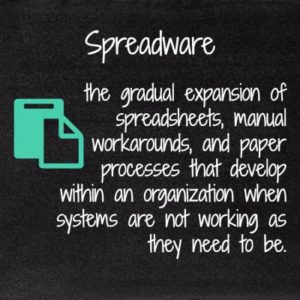There is a malaise, almost like a disease, that spreads throughout offices and workforces. It happens when systems don’t do what they should or can’t offer capabilities a non-cookie cutter business structure requires. An employee can’t do it within the system, so they find a workaround outside it.
There is a term for this epidemic in workforces. It’s called “spreadware.” It’s the gradual expansion of spreadsheets, manual workarounds, and paper processes that develop within an organization when systems are not working as they need to.

Spreadware: the gradual expansion of spreadsheets, manual workarounds, and paper processes that develop within an organization when systems are not working as they need to be.
Almost every organization I meet with has this problem. It is a serious and insidious one since most often we are not even aware that we have it or how seriously it has spread. I think of it as similar to gaining weight; I gain the pounds slowly over time, before I know it, I am 20 pounds overweight and opting for the elastic banded waists. (Why is it so easy to put on the pounds and so hard to take them off?) I believe spreadware is worse.
Spreadware is an organization-wide issue with each individual working at an organization affected, not only one person. And the signs are truly insidious as no-one works in a vacuum, so our spreadware is then contagious.
Why does Spreadware happen?
So why is spreadware happening? My theory follows the “life will find a way” philosophy. Human beings who have a need will find a way to fill that need. In the business world, that usually means spreadsheets and manual processes and many, many pieces of paper.
Our systems should be providing us what we need, but they’re not. And spreadware happens.
The more we can’t get from our systems, the more workarounds we create to fill that need. And it infects our entire organizations.
What’s the cure? As we often hear, the first step to a cure is admitting that you have a problem. Once you recognize that fact, then you need to understand the cost to your organization. The simplest method to start is to estimate the raw cost.

For example, take the estimated number of spreadware hours per employee multiplied an average annual salary. If you have 100 employees with an average annual salary of $50,000 and we estimate a very conservative average of 8 hours per week spent on spreadware activities, spreadware has a direct cost to our organization of almost $20,000 annually. And those totally wasted dollars don’t account for “lost opportunity” costs, errors, lack of visibility, etc. where spreadware further impacts an organization.
1.Identify the cause
The true cure then follows with how we eradicate the spreadware epidemic and that means looking to the root cause—our systems.
When we say we can’t afford new systems, we need to remember the true cost of our out-dated systems and realize we can’t afford to not do something. Organizations need, and I would argue require, systems that contribute to the health and well-being of the operations of an organization for it is only in that way that organizations can be most effective in meeting their mission.
2. Align your needs with the right system
The next step is aligning your needs with the appropriate system, and making sure that the system you select works with the culture of your organization. We all know the shell-shocked faces of those who are diehard Outlook people when they are told that the office is moving to the cloud and Gmail will be their new mode of email communication. You can almost feel the fear rising up in them as they are about to be pushed out of their comfort zone. If you don’t take the medicine it won’t work. Getting early buy-in and implementing effective processes and training are essential to getting a lasting cure.
3. Don’t neglect checkups
Organizations also need to take the time to get a check up every now and then. Get an annual exam to ensure the changes are working for everyone involved and that they are continuing to build strength rather than atrophy.
The solution is not going to be a quick fix, but nothing that is really going to cure the epidemic long term can just be another band-aid. JMT Consulting can help you diagnose, find the cure and keep your team in tip top shape, no elastic waistbands required.


